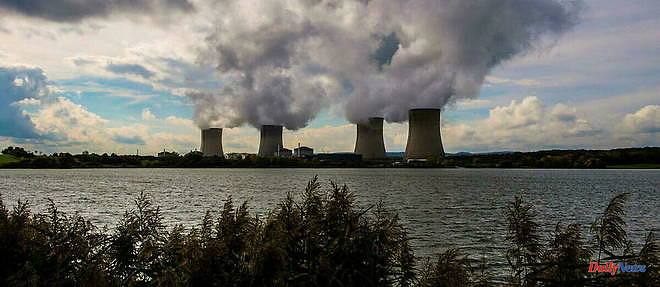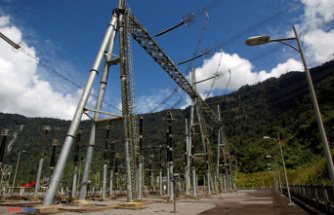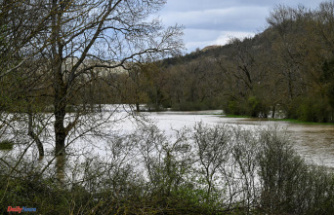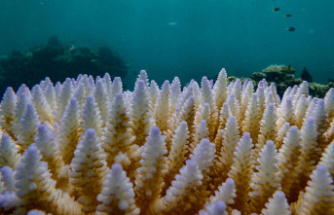In February 2021, heavy snowfall occurred around the Cattenom nuclear power plant in Moselle. The vicinity of the atomic site was covered with several tens of centimeters of snow while the rest of the region remained dry. The water emitted by the plant, necessary for its cooling, had condensed and had settled on the ground, covering the earth with a white coat.
This spectacular event is a reminder that nuclear power plants equipped with air coolers inject water into the atmosphere to transfer thermal energy to the outside air: their iconic white plumes are formed from water droplets that quickly evaporate and disappear from view, but the vapor is still there (it is transparent).
What is perhaps a little less well known is that water vapor (H20) is a greenhouse gas, i.e. its presence in the atmosphere limits the capacity of the Earth to cool itself by emitting infrared radiation into space. Its contribution is greater than that of carbon dioxide (CO₂) or methane (CH₄), because the latter are present in trace amounts: there is typically ten times more water vapor than CO2 in the atmosphere.
The water vapor argument is sometimes put forward by climate skeptics who wish to put the impact of our CO₂ emissions into perspective, or by anti-nuclear supporters who wish to show that these power plants contribute to global warming through their emissions of CO₂. water.
However, even if the water cycle (steam and clouds) is a major component of the climate, we know that these human emissions from the surface of the Earth do not have a significant impact.
This is because the ability of air to dissolve water is physically limited: above a certain concentration, the vapor will condense and become liquid. Condensation can take place in the atmosphere, which leads to the formation of clouds. It can also occur on cold surfaces, which explains the formation of dew on the ground, or fog on the windows. When atmospheric conditions are favorable, clouds lead to precipitation, which removes water from the atmosphere.
Any additional quantity of water vapor injected into the atmosphere from the surface will therefore condense and then precipitate, leading to a negligible climatic impact since the concentration is not significantly modified over the long term.
Thus, unlike CO2, the concentration of water vapor is regulated in the lower layers of the atmosphere, which means that additional emissions have little impact on the concentration, and therefore on the greenhouse effect.
Note that this is true for emissions "from the surface" of the Earth that remain in the lower part of the atmosphere, called the troposphere.
On the other hand, the water vapor injected at altitude, in particular by air traffic but also by the oxidation of methane, ends up in atmospheric layers which are often far from "saturation", and this water vapor emitted at altitude is not quickly eliminated by rain.
While human emissions of water vapor from the surface do not therefore contribute significantly to the increase in the greenhouse effect, water vapor in these lower layers remains a key driver of climate change, via an indirect mechanism: water vapor is not the cause of the warming, but if there is warming (for example due to the increase in CO2 concentration), it contributes to making it worse by preventing the Earth from cool down (by retaining infrared emissions).
As mentioned previously, the air can contain a certain quantity of water in the form of vapor without there being any condensation. This amount is highly dependent on temperature: cold air (polar-like or at high altitudes) contains very little water, while warm air (as found in the lower layers of a tropical atmosphere) can hold a lot of water. 'water. The relationship between temperature and the amount of water vapor that can be held in the air is non-linear (about 7% per additional degree).
If the temperature rises due to anthropogenic CO2 emissions, the air can hold more water vapour. In practice, this is indeed what happens and the additional water vapor in the air will then contribute to the greenhouse effect, reinforcing the initial warming.
Thus, the water vapor will contribute to amplifying the initial effect (rise in temperature), even if it is not the cause. This is called "positive feedback".
"Feedback" is a process that takes place following an initial disturbance and reinforces it (positive feedback) or dampens it (negative feedback).
In the context of global warming, an example of a strong negative feedback is related to the emission of infrared radiation: as the temperature rises, the atmosphere, ocean, and surfaces emit more infrared radiation to space, which allows heat to be "drained" from Earth to space, and induces cooling.
On the "positive feedback" side, we saw the example of water vapor in the atmosphere. This effect, which is well understood and therefore included in climate models, multiplies the initial warming by a factor close to 3. It is therefore essential for understanding the extent of global warming.
Another example is that of snow and sea ice: with warming, their surfaces tend to decrease. Since snow and pack ice reflect a large part of solar radiation back into space, their disappearance causes additional absorption of solar energy in the ground, and therefore additional warming.
Clouds also have the potential to be the vector of feedback. But their impact is complex since, at the same time, they reflect part of the solar radiation towards space (cooling effect) and they contribute to the greenhouse effect (warming effect). Moreover, the impact of global warming on cloud cover and altitude is not obvious. Climate models indicate that, ultimately, clouds lead to a positive feedback, but its magnitude remains uncertain since it differs between models.
Unlike "feedbacks", "forcings" are the human actions that lead to climate change. Water vapor emissions do not constitute a significant forcing, but water vapor is indeed the vector of an essential feedback to quantify the amplitude of global warming.
* François-Marie Bréon, physicist-climatologist, researcher at the Laboratory of Climate and Environmental Sciences, Sorbonne University












